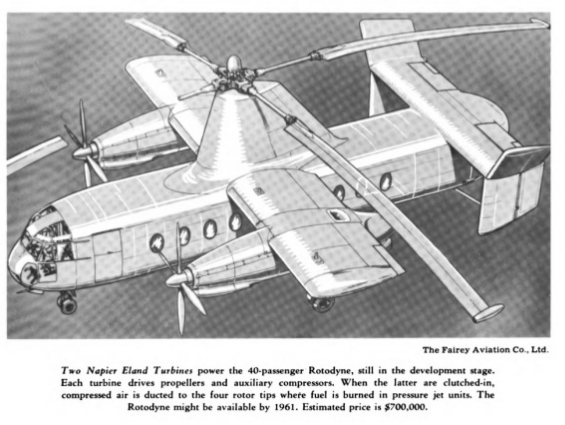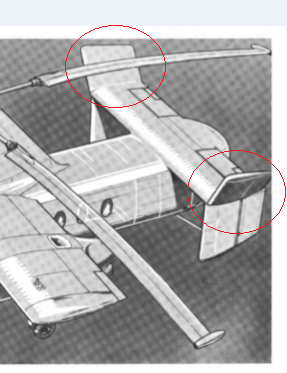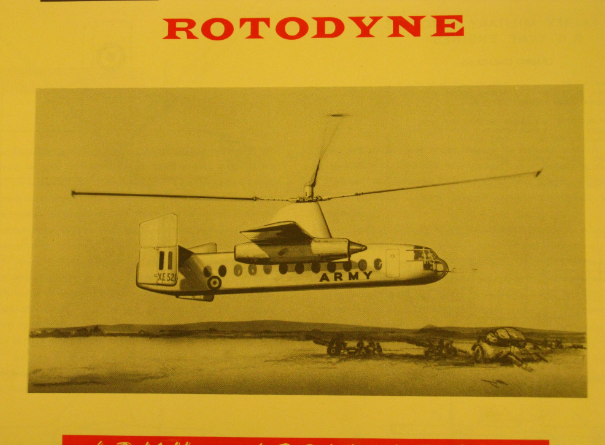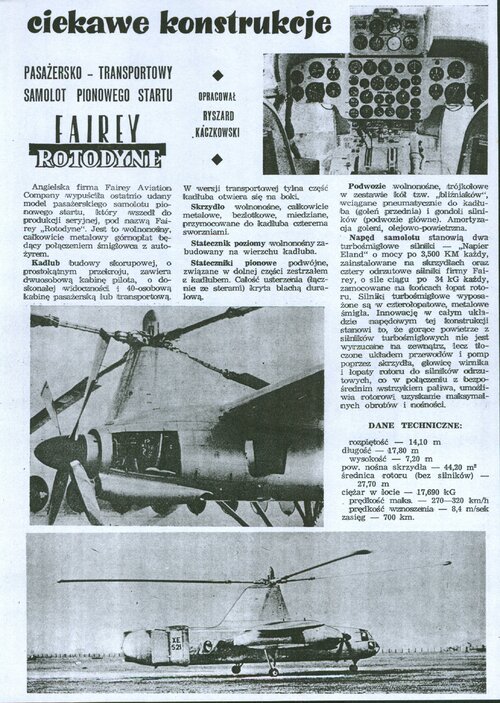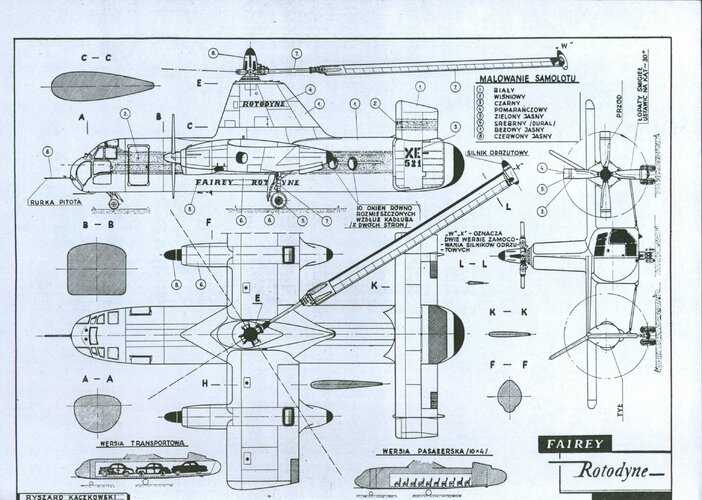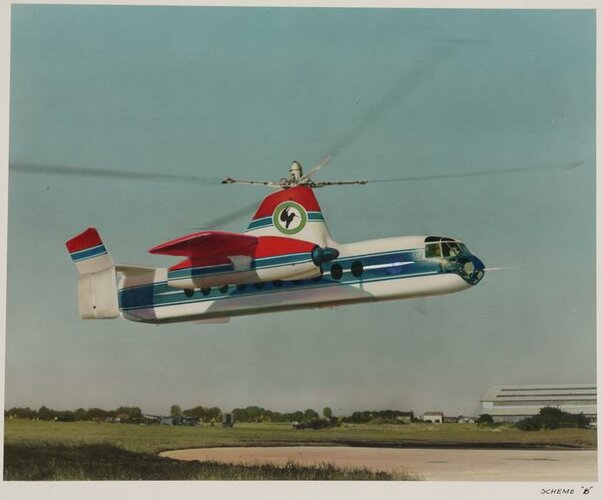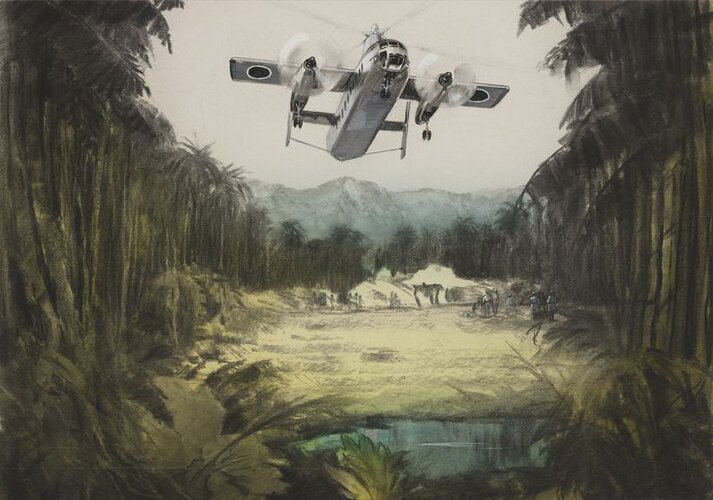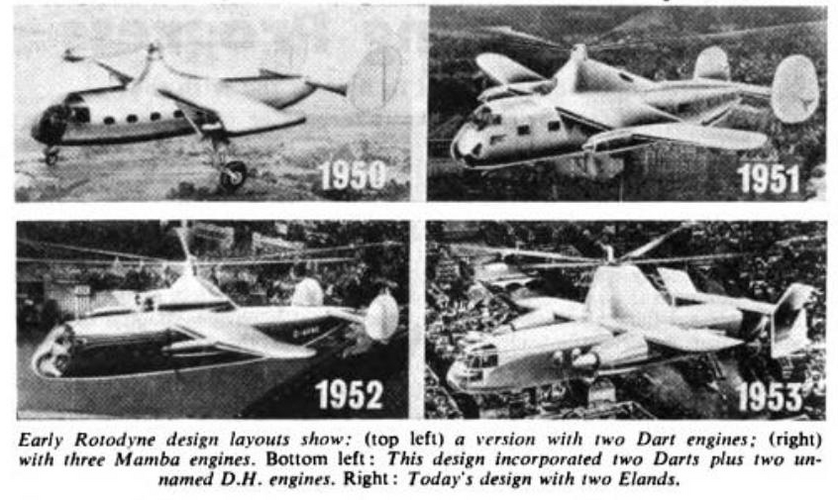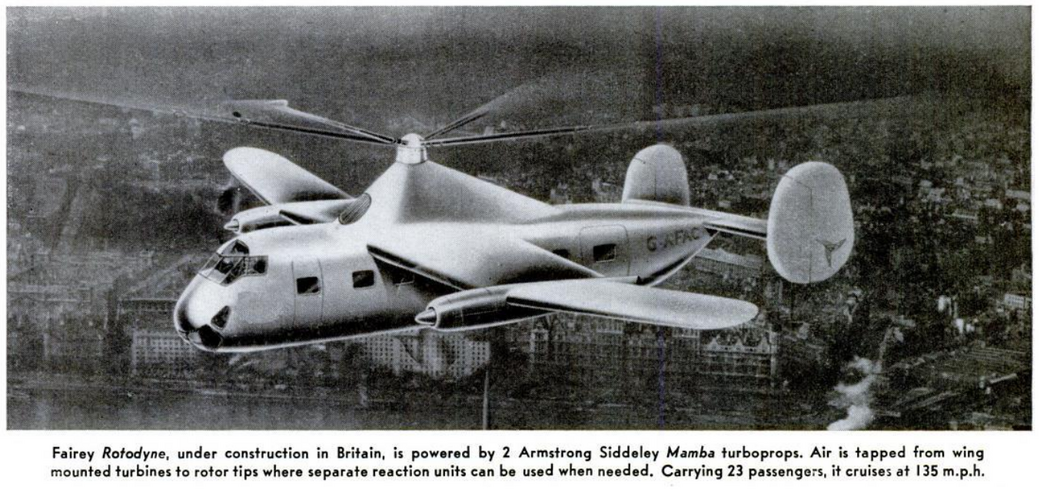Yes, I think that building heliports on top of major railway stations (and thereby linking directly into the Underground and other transport nodes) is the most obvious way to provide successful heliports.have a book on past and proposed developments in Manchester, one of the proposals was to build a helipad over the lines of Victoria Railway station, I suppose other stations in other cities would have been appropriate sites for similar developments - the rail approach to Euston Station springs to mind.
You are using an out of date browser. It may not display this or other websites correctly.
You should upgrade or use an alternative browser.
You should upgrade or use an alternative browser.
The Fairey Rotodyne
- Thread starter rocketeer
- Start date
some smaller autogyro project:
 www.fraundorfer.aero
www.fraundorfer.aero
one prototype is already flying.
Home | Tensor
The Multipurpose WordPress & WooCommerce Theme that helps you build ANY type of website in no time. Design visually with the best Live Builder for WordPress you ever met.
one prototype is already flying.
- Joined
- 11 March 2006
- Messages
- 8,618
- Reaction score
- 3,762
- Joined
- 18 October 2006
- Messages
- 4,203
- Reaction score
- 4,880
I imagine the reason for the outward bend to the vertical stabilizers has to do with the potential flexing of the rotor systems while in autorotative flight (forward flight for rotordynes).
I understand that progress in reducing the noise was made, but I think that was not enough to rescue the project.'Urban Legend' holds that Rotodynes' LOUD 'organ pipe' resonance was solved, but too late to prevent yet-another politically motivated project cancellation.
How true ??
According to a book I have Rotodyne, a Canadian Firm: a Canadian equivalent of Bristow, was very interested in it and had produced advertising material for the projected service (sorry I can't more accurate but it's one of my books in storage), Kaman were also interested in licence producing it for the North American market.
Flying Sorcerer
ACCESS: Confidential
- Joined
- 18 June 2008
- Messages
- 129
- Reaction score
- 97
Okanagon Helicopters was planning to fly them between Vancouver and Victoria. The father of one of my elementary school friends worked for them.
taildragger
You can count on me - I won a contest
- Joined
- 2 November 2008
- Messages
- 405
- Reaction score
- 507
Kaman actually had a licensing agreement in place and was advertising in trade publications.Kaman were also interested in licence producing it for the North American market.
taildragger
You can count on me - I won a contest
- Joined
- 2 November 2008
- Messages
- 405
- Reaction score
- 507
My understanding is that the folding tips were kept straight in flight and only folded on the ground before slowing the rotor. If it weren't for the forward flight mode, the fins would be pointless.I imagine the reason for the outward bend to the vertical stabilizers has to do with the potential flexing of the rotor systems while in autorotative flight (forward flight for rotordynes).
- Joined
- 6 September 2006
- Messages
- 4,824
- Reaction score
- 9,410
Okanagon Helicopters announced an order for 1 plus options for 2 more at the 1958 Farnborough Show. The Type Y prototype had been flying since November 1957 but hadn't made its first transition until April 1958.
In late 1958 Japan Airlines were looking at 2 Type Z plus 4 options.
In March 1959 New York Airlines had ordered for 5 Type Z from Fairey plus an option for 15, these 15 would have been built by Kaman under the licence to manufacture and as sales and servicing agents in the USA.
Despite being shown at Paris (including a flight to Brussels with SABENA execs aboard) and Farnborough in 1959, no further orders materialised. Noise trials began at Battersea just prior to the 1959 Farnborough show. These noise continued during 1960 and in March 1961 Battersea was used for Operation Snowdrop.
In October 1961 BEA finally issues a Type Spec for 6 Type Z plus options for 6 more after years of discussions and indecision since the formal start of development in 1953.
The RAF were still undecided about its Light Tactical Transport, favouring the DHC Caribou but with HP and Avro pitching Herald and 748 variants.
In 1960 Westland took over all the helicopter manufacturing assets in the UK, acquiring Fairey's programme in February and cancelling its own Westminster that November.
In mid-1961 Rolls-Royce took over Napier and with the restructuring etc. taking place they said they could not guarantee Tyne delivery dates , which was a blow as Okanagon and NY Airlines had contracted delivery dates. Development costs were also increasing which was pushing up prices.
By 1962 the RAF was ignoring Rotodyne, in April 1963 for politically motivated reasons the 748MF was ordered as the Andover over the HP.24 Military Dart Herald.
Even before this decision it was clear that BEA would have to carry the R&D costs alone. Always lukewarm about the project, they withdraw their order.
Okanagon, NY and Japan Airlines immediately cancelled. The government offered Westland the chance to proceed as a private-venture for BEA, but neither was interested and government funding ended in late February 1962. The Type Z at this stage was still in the mock-up phase with static rig tests still in the preliminary phase.
So that brings us to a grand total of 14 aircraft plus 27 options (15 to be made by Kaman). All ordered while Type Y trials were still underway. Perhaps more might have followed once the Type Z was flying but realistically its hard to imagine production aircraft would have been ready before 1964. There just wasn't the market for larger inter-city VTOL transport, even helicopter routes took time to get established and they endured a bumpy time during the 1960s and 1980s and still hasn't materialised even today.
There was an article in Aeroplane Monthly a couple of months ago about Caledonian's Heathrow-Gatwick helicopter shuttle service that got grounded by the government off the back of public protest about noise in the 1970s (flying over Surrey mansions wasn't popular with the NIMBY locals).
Had Rotodyne carried on and had the US Army or USAF gotten interested in using Rotodynes in SE Asia, then maybe Kaman might have gained a big order book. But that's all very what-if conjecture.
The truth is, if BEA and the RAF were lukewarm then why would anybody else get behind it?
In late 1958 Japan Airlines were looking at 2 Type Z plus 4 options.
In March 1959 New York Airlines had ordered for 5 Type Z from Fairey plus an option for 15, these 15 would have been built by Kaman under the licence to manufacture and as sales and servicing agents in the USA.
Despite being shown at Paris (including a flight to Brussels with SABENA execs aboard) and Farnborough in 1959, no further orders materialised. Noise trials began at Battersea just prior to the 1959 Farnborough show. These noise continued during 1960 and in March 1961 Battersea was used for Operation Snowdrop.
In October 1961 BEA finally issues a Type Spec for 6 Type Z plus options for 6 more after years of discussions and indecision since the formal start of development in 1953.
The RAF were still undecided about its Light Tactical Transport, favouring the DHC Caribou but with HP and Avro pitching Herald and 748 variants.
In 1960 Westland took over all the helicopter manufacturing assets in the UK, acquiring Fairey's programme in February and cancelling its own Westminster that November.
In mid-1961 Rolls-Royce took over Napier and with the restructuring etc. taking place they said they could not guarantee Tyne delivery dates , which was a blow as Okanagon and NY Airlines had contracted delivery dates. Development costs were also increasing which was pushing up prices.
By 1962 the RAF was ignoring Rotodyne, in April 1963 for politically motivated reasons the 748MF was ordered as the Andover over the HP.24 Military Dart Herald.
Even before this decision it was clear that BEA would have to carry the R&D costs alone. Always lukewarm about the project, they withdraw their order.
Okanagon, NY and Japan Airlines immediately cancelled. The government offered Westland the chance to proceed as a private-venture for BEA, but neither was interested and government funding ended in late February 1962. The Type Z at this stage was still in the mock-up phase with static rig tests still in the preliminary phase.
So that brings us to a grand total of 14 aircraft plus 27 options (15 to be made by Kaman). All ordered while Type Y trials were still underway. Perhaps more might have followed once the Type Z was flying but realistically its hard to imagine production aircraft would have been ready before 1964. There just wasn't the market for larger inter-city VTOL transport, even helicopter routes took time to get established and they endured a bumpy time during the 1960s and 1980s and still hasn't materialised even today.
There was an article in Aeroplane Monthly a couple of months ago about Caledonian's Heathrow-Gatwick helicopter shuttle service that got grounded by the government off the back of public protest about noise in the 1970s (flying over Surrey mansions wasn't popular with the NIMBY locals).
Had Rotodyne carried on and had the US Army or USAF gotten interested in using Rotodynes in SE Asia, then maybe Kaman might have gained a big order book. But that's all very what-if conjecture.
The truth is, if BEA and the RAF were lukewarm then why would anybody else get behind it?
- Joined
- 9 October 2009
- Messages
- 21,928
- Reaction score
- 13,537
Quite possible that the Royal Air Force took umbrage.
Actually they fix the noise issue, only around 90 decibels by the time the program was canceled, not much higher then a regular helicopter and the flow and landed the "Y" in the middle of London and got zero complaints before the noise reduction messers, it wasn't noise that killed the rotodyne, it was the government not willing to spend 10,000,000 to finish the project despite haveing already spent 26,000,000 already (aka every British aero space project that was canceled between 1945 and 1970).ISTM that the whole tip jet idea was simply not a success. Not only loud, but an ear busting frequency. Offhand, does anyone know of any tip jet copters that went into service?
Last edited:
- Joined
- 19 October 2012
- Messages
- 1,980
- Reaction score
- 1,931
There are a lot of questionable statements in that, not least the usual 'it was the politics wot killed it'. The noise issue had not been fixed; there were proposals in place but yet to be proven, not least given that the production Rotodyne would have been powered by R-R Tynes producing nearly double the power of the Elands. That there were no complaints made after the small number of test flights in London is no indication at all that the noise would have proven acceptable for routine commercial flights. The total spend on the Rotodyne project prior to cancellation was announced as a bit over £13 million. The project, now a larger, heavier and completely redesigned aircraft, could have continued but neither R-R nor Fairey/Westland had sufficient confidence in the commercial viability of the project as it stood.Actually they fix the noise issue, only around 90 decibels by the time the program was canceled, not much higher then a regular helicopter and the flow and landed the "Y" in the middle of London and got zero complaints before the noise reduction messers, it was noise that killed the rotodyne, it was the government not willing to spend 10,000,000 to finish the project despite haveing already spent 26,000,000 already (aka every British aero space project that was canceled between 1945 and 1970).ISTM that the whole tip jet idea was simply not a success. Not only loud, but an ear busting frequency. Offhand, does anyone know of any tip jet copters that went into service?
- Joined
- 26 May 2011
- Messages
- 2,316
- Reaction score
- 3,467
It was a bit more complicated than that. All covered in the Air Staff and the Helicopter. Essentially boiled down to whether the military or civil sectors would pay for the R&D with each planning for the other to cough up the cash. I got the impression that The Treasury was piggy-in-the-middle, got fed up with the arguments and called a halt to the whole project.
On the 'just like every other project between 1945 and 1970' front. All had good reasons for going ahead, but even better reasons for not going ahead as time, threats and world events panned out differently to what was expected.
For example the HS.681. Since the HS.681 was cancelled I can think of only one operation where its V/STOL transport capability was a must have - Op Eagle Claw.
As an aside/ is a Chinook noisier than a Rotodyne?
Chris
On the 'just like every other project between 1945 and 1970' front. All had good reasons for going ahead, but even better reasons for not going ahead as time, threats and world events panned out differently to what was expected.
For example the HS.681. Since the HS.681 was cancelled I can think of only one operation where its V/STOL transport capability was a must have - Op Eagle Claw.
As an aside/ is a Chinook noisier than a Rotodyne?
Chris
- Joined
- 19 October 2012
- Messages
- 1,980
- Reaction score
- 1,931
Noise is a tricky beast. The Chinook produces a very low frequency beat from the rotors as the main noise, makes the windows and everything in the house shake as they pass over on their way to Odiham. Its loud, for sure, but not too disturbing. I guess, but have no personal experience, that the tip jets on the Rotodyne would have produced a shriek involving far higher frequencies on top of the rotor beat. Descriptions suggest that it was painful to hear. Our perception of noise and its disturbance is dominated by the frequency mix rather than the measured dB.As an aside/ is a Chinook noisier than a Rotodyne?
Chris
- Joined
- 6 September 2006
- Messages
- 4,824
- Reaction score
- 9,410
Well thanks to the BBC Sound Archive you can listen to the Rotodyne. Presumably these must have been taken during the noise measurement trials at Battersea.
https://sound-effects.bbcrewind.co.uk/search?q=rotodyne
Not a particularly pleasant sound, sure if you're not near the landing pad you might not give it a second thought but if you are...
Of course aviation noise limits overall are much lower now, you can hear an incoming Hercules or An-12 over quite some distance (I've heard incoming low-flying Chinooks indoors from the opposite side of an office building with windows and doors closed) and no doubt if Viscounts were still flying we'd be moaning about the din compared with modern turborprops with modern propellers. Not sure we'd want first gen 707s or 727s whining overhead regularly either.
As Schneiderman says, commercial viability was key. As I pointed out in a lengthy post above, the world's airlines were not beating a path to Yeovil's door waving cheque books for this revolutionary world-beating mode of transport. 8 firm orders is about 992 airframes shy of beating a word-beating commercial aircraft...
https://sound-effects.bbcrewind.co.uk/search?q=rotodyne
Not a particularly pleasant sound, sure if you're not near the landing pad you might not give it a second thought but if you are...
Of course aviation noise limits overall are much lower now, you can hear an incoming Hercules or An-12 over quite some distance (I've heard incoming low-flying Chinooks indoors from the opposite side of an office building with windows and doors closed) and no doubt if Viscounts were still flying we'd be moaning about the din compared with modern turborprops with modern propellers. Not sure we'd want first gen 707s or 727s whining overhead regularly either.
As Schneiderman says, commercial viability was key. As I pointed out in a lengthy post above, the world's airlines were not beating a path to Yeovil's door waving cheque books for this revolutionary world-beating mode of transport. 8 firm orders is about 992 airframes shy of beating a word-beating commercial aircraft...
- Joined
- 19 October 2012
- Messages
- 1,980
- Reaction score
- 1,931
One of my fondest childhood memories is of lying in bed listening to Viscounts droning overhead after taking off from Gatwick on a summer's evening. To a kid's ears it was no din...... no doubt if Viscounts were still flying we'd be moaning about the din compared with modern turborprops with modern propellers.
- Joined
- 6 September 2006
- Messages
- 4,824
- Reaction score
- 9,410
Whenever I hear aircraft on old pre-90s television programmes it triggers sound memories of my childhood before the noise regs killed off the older airliners. A noisy turboprop used to fly over at 4am every morning when I was young. Probably a parcel/mail flight to/from the Low Countries. Alas plane tracking apps were a fantasy back in those days.One of my fondest childhood memories is of lying in bed listening to Viscounts droning overhead after taking off from Gatwick on a summer's evening. To a kid's ears it was no din...... no doubt if Viscounts were still flying we'd be moaning about the din compared with modern turborprops with modern propellers.. sometimes we would go down to the end of the runway and wait for one to take off and one to land, plenty of time to eat an ice cream.
klem
I really should change my personal text
- Joined
- 7 March 2015
- Messages
- 725
- Reaction score
- 1,633
- Joined
- 19 October 2012
- Messages
- 1,980
- Reaction score
- 1,931
A book you might find helpfull.Hi all.Im brand new here and enjoying the site 100%.
So can anyone provide any info on Rotodyne projects please?? ??? ???
Remember seeing an article in an old Flight mag about a Naval Variant but have seen nothing since!!
Help please.
Fairey Rotodyne by David Gibbings, https://www.thehistorypress.co.uk/publication/fairey-rotodyne/9780752449166/
I guess the best book around. Good Luck
- Joined
- 20 January 2007
- Messages
- 953
- Reaction score
- 1,141
To add a detail to Hood #98 above and to CJG, Air Staff and Heli, P.25, spelling out waning UK military interest: MoA (in its industry-sponsor role, clashing constantly with its military procurment role)/AD/Aircraft Research (with such oddities as SC.1, Hunting Jet Flap...) had 1961 input from Br.Defence Research and Supply Staff in UK Embassy/DC on USMC "Heavy Helicopter Experimental" Reqt., which, long in gestation, had been Kaman's 1958 motive in taking a Rotodyne licence. It was his judgement that USMC would urge a proper chopper (to be S-65/CH-53A) to distance themselves from US' own Rotodyne-ish USN/USAF/USArmy tiltwing (to be) Vought XC-142: that curbed him. Funding XC-142 was concurrent with unfunding Rotodyne. Nothing to do with alleged Westland preference for Westminster or S-61.
Last edited:

Fairey Rotodyne compound helicopter (Print) | Science Museum Group Collection
Fairey Rotodyne compound helicopter, brochure 1950-55, artwork c.1958 based on photograph of prototype
Attachments

Fairey Rotodyne military transport helicopter (Print) | Science Museum Group Collection
Fairey Rotodyne military transport helicopter, project (1950-55)
Attachments
View: https://twitter.com/clark_aviation/status/1594954583536648192
The sound of the Rotodyne was unique.
Flyover:

Startup:

The sound of the Rotodyne was unique.
Flyover:

Startup:

Similar threads
-
Fairey Tactical Strike Aircraft GOR.339 Project 75
- Started by Welshy42
- Replies: 12
-
-
-
-
F.155T the last minute submissions
- Started by zen
- Replies: 9

